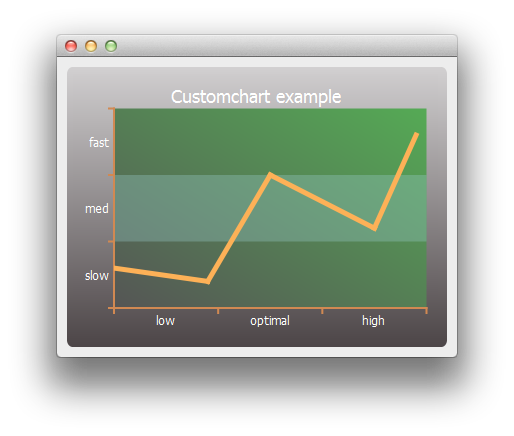自定义图表
注: 这是 "带 Widgets 图库的图表"示例的一部分。

我们首先创建一个简单的线性数列和一个图表对象。
auto series = new QLineSeries; *series << QPointF(0, 6) << QPointF(9, 4) << QPointF(15, 20) << QPointF(25, 12) << QPointF(29, 26); auto chart = new QChart; chart->legend()->hide(); chart->addSeries(series);
首先,我们自定义系列以及图表的标题和背景。
// Customize series QPen pen(QRgb(0xfdb157)); pen.setWidth(5); series->setPen(pen); // Customize chart title QFont font; font.setPixelSize(18); chart->setTitleFont(font); chart->setTitleBrush(QBrush(Qt::white)); chart->setTitle("Custom Chart"); // Customize chart background QLinearGradient backgroundGradient; backgroundGradient.setStart(QPointF(0, 0)); backgroundGradient.setFinalStop(QPointF(0, 1)); backgroundGradient.setColorAt(0.0, QRgb(0xd2d0d1)); backgroundGradient.setColorAt(1.0, QRgb(0x4c4547)); backgroundGradient.setCoordinateMode(QGradient::ObjectBoundingMode); chart->setBackgroundBrush(backgroundGradient); // Customize plot area background QLinearGradient plotAreaGradient; plotAreaGradient.setStart(QPointF(0, 1)); plotAreaGradient.setFinalStop(QPointF(1, 0)); plotAreaGradient.setColorAt(0.0, QRgb(0x555555)); plotAreaGradient.setColorAt(1.0, QRgb(0x55aa55)); plotAreaGradient.setCoordinateMode(QGradient::ObjectBoundingMode); chart->setPlotAreaBackgroundBrush(plotAreaGradient); chart->setPlotAreaBackgroundVisible(true);
然后自定义坐标轴。
auto axisX = new QCategoryAxis; auto axisY = new QCategoryAxis; // Customize axis label font QFont labelsFont; labelsFont.setPixelSize(12); axisX->setLabelsFont(labelsFont); axisY->setLabelsFont(labelsFont); // Customize axis colors QPen axisPen(QRgb(0xd18952)); axisPen.setWidth(2); axisX->setLinePen(axisPen); axisY->setLinePen(axisPen); // Customize axis label colors QBrush axisBrush(Qt::white); axisX->setLabelsBrush(axisBrush); axisY->setLabelsBrush(axisBrush); // Customize grid lines and shades axisX->setGridLineVisible(false); axisY->setGridLineVisible(false); axisY->setShadesPen(Qt::NoPen); axisY->setShadesBrush(QBrush(QColor(0x99, 0xcc, 0xcc, 0x55))); axisY->setShadesVisible(true);
然后是坐标轴标签值和范围。坐标轴准备就绪后,我们将其设置为图表使用。
axisX->append("low", 10); axisX->append("optimal", 20); axisX->append("high", 30); axisX->setRange(0, 30); axisY->append("slow", 10); axisY->append("med", 20); axisY->append("fast", 30); axisY->setRange(0, 30); chart->addAxis(axisX, Qt::AlignBottom); chart->addAxis(axisY, Qt::AlignLeft); series->attachAxis(axisX); series->attachAxis(axisY);
最后,我们创建一个包含图表的视图。
createDefaultChartView(chart);
现在我们可以在主窗口中显示图表了。
© 2025 The Qt Company Ltd. Documentation contributions included herein are the copyrights of their respective owners. The documentation provided herein is licensed under the terms of the GNU Free Documentation License version 1.3 as published by the Free Software Foundation. Qt and respective logos are trademarks of The Qt Company Ltd. in Finland and/or other countries worldwide. All other trademarks are property of their respective owners.

